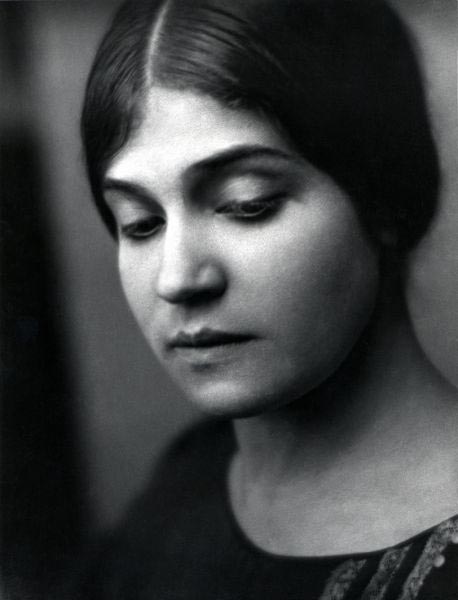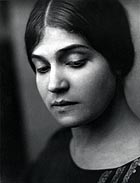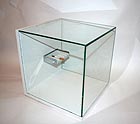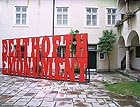
translated and summarized by: Liz Wollner-Grandville,
English summary August 16 - September 4
Kunsthaus Wien
Tina Modotti – Photographer and Revolutionary
01.07.10 – 7.11.10
Propaganda with a human face
Socio-documentary photography always fought with its own ambivalence: on the one hand, in its attempt to at least depict extracts of realities in order to heighten awareness. After all, the image was meant to benefit those depicted. And on the other hand, not to base one’s reputation on this benefit, but on the formal power of the artwork, in other words to serve and to cultivate artistic criteria. But alone the request to let the alleged pure documentation serve an educational cause is connected to the implicit understanding that depiction is also always a kind of mise-en-scène. After all – its goal is set something in motion.
But as generally known, there are infinite variations of pure art and pure propaganda. One of them is definitely Tina Modotti’s position (1896 – 1942). Her black-and-white photos are probably among the most significant of the first half of the 20th century. Modotti’s most famous pictures deal with symbols and situations of social and political battles. On the one hand they report about tedious life in the country in the south of post-revolutionary Mexico and about the difficult working conditions of employees in Mexico-City. On the other hand they show strict arrangements of objects and people that have become icons of the workers’ movement: the “Woman with the Flag” (1928), the four Mexican farmers hidden behind their sombreros reading the communist party’s newspaper “El Machete”, and even the detailed picture of Antonio Mella’s typewriter, the Cuban communist and Modotti’s murdered companion.
In the early 1930’s, Modotti devotes herself to the political battle. She moves to Moscow and then, similar to many of her leftwing colleagues, she joins the Spanish Civil War (1936 – 1939). While people like Gerda Taro, Robert Capa and Kathi Horna proceed with the socio-documentary dilemma in a remarkably fruitful way, Modotti turns into a pragmatic party communist. In addition to propaganda with a human face, the retrospective also shows structural photography, women’s portraits, reproductions of paintings and genre pictures from the impressive oeuvre of the activist artist.
By Jens Kastner
Kunsthaus Wien
1030 Vienna, Untere Weißgerberstr 13
www.kunsthauswien.at
Opening hours: daily from 10 a.m. to 7 p.m.
Galerie Eugen Lendl
Christian KRI Kammerhofer – defeKT
11.08.10 – 11.09.10
High heels at the domestic shrine
The most defiant work in Christian KRI Kammerhofer’s exhibition is displayed in the first room of the Galerie Lendl: a cigarette in an ashtray placed under a glass cube. The work is titled “Smoking Area”; how long will it take until smoking areas will be reduced to a few cubic centimetres? In a time, in which the ubiquitous health-hazard smoking is part of heated political debates it is not far-fetched to create polemic art works dealing with the topic.
The artist, born 1971, takes up topics that have been dealt with by magazines as well as non-fiction books for years if not decades: shoe fetish (with high-heels assemblages in a domestic shrine) as well as hectic everyday life (with manipulated clocks – and one, with its hands tied down with locks).
In the installation “Tears” things become even simpler: water drips out of two plastic bottles onto a table; the liquid is then passed on into a container standing beneath it. The bottles as a male - and the table as a female element? The installation couldn’t be more antiquated.
Yet one should not underestimate Kammerhofer: his better works reflect sculpture in a humorous way. In one of his videos (to be seen on youtube) he wraps a
chair in tin foil, positions its ephemeral replica into a corner and tries to sit on it. Or he lets his initials - written in butter - melt in a pan and shows the process in rewind mode. He might not have reinvented the wheel, but his works can definitely be conceived as a serious way of dealing with matter and space.
By Nina Schedlmayer
Galerie Eugen Lendl – Palais Lengheimb
8010 Graz, Bürgergasse 4/1
www.eugenlendl.com
Opening hours: Tue-Fri 11 a.m. – 7 p.m., Sat 10 a.m. – 1 p.m.
Haus der Kunst
Contemporary Art Exhibition 2010
11.08.10 – 03.11.10
Memory loop
Some pictures imprint themselves so deeply in the subconscious that we would even recognize them in a completely blurred or altered state, such as familiar faces or well-known places. In Francisco and Markus Schork' video, sharply focused and blurred images are merged and one can detect a river flowing from right to left – with children playing on the riverbanks, and joggers hustling by. In the middle: a tree with a wide forked branch. A normal landscape? Not at all, even in its blurred state, every Munich resident would recognize that the scene is set in the English Garden, in immediate vicinity of the Haus der Kunst. The video is a livestream of what is going on behind the museum.
But what is it that sparks this recognition-stimulus? Is it the marked forked branch, the blazing sunlight which lets the tree tops shimmer, or is it the speed of the current? Or is it all of this, an atmosphere that only comes about at exactly this venue in Munich’s English Garden? The video questions the significance of reading a picture or recognizing a picture and it is one of the best works presented at the “Large Art Exhibition” at the Haus der Kunst. Under the title “Im Haus” (In the house) the exhibition displays 150 contemporary works. Numerous paintings, installations, videos and photo series deal with the topic: Andrea Borowski portrayed couples, families and singles in their apartments. One could also say that she portrayed the apartments of couples, families and singles. In any case, this is all about the relationship of human beings and their environment, a kind of sociology of the living room. With her series “66 glances before undressing”, Regine Chossy questions the self-staged living situation and thereby the identity of the rooms. The photo series shows details of an apartment – from the keyhole to the fruit basket, the clothesline, the bookshelf to the ruffled bed. It deals with the intimacy of privacy, but also with the strangeness in what is familiar.
Other artists, especially sculptors, refer to classic architectural forms of houses: the familiar cube with its gabled roof appears in the same way it is depicted in children’s sketches or in ads – as the archetype replacement for the long desired home. While most artists deal with concrete rooms and houses, Albert Coers concentrates on the spiritual home: he constructs an igloo made of children’s books, referring to the state of complete absent-mindedness and of the possibility to feel as if one were in a second reality in a book – similar to Michael Ende’s “Never-ending Story” in which the main character, the young boy Bastian, becomes part of the story that he is just reading. At this exhibition venue, a former Nazi-building, Albert Coers’ work attains yet another connotation: on the one hand, the heaps of children’s books remind of the Nazi book-burning and on the other hand, of the first post-war exhibition that took place at the Haus der Kunst: it was devoted to children’s and youth literature. This is an exhibition with strong individual positions well-worth seeing!
By Astrid Mayerle
Haus der Kunst
80538 Munich, Prinzregentenstrasse 1
www.grossekunstausstellungmuenchen.de
Opening hours: Daily from 10 a.m. to 8 p.m.
Galerie im Traklhaus
Marko Lulic
06.08.2010 – 18.09.2010
Death to monuments
The artist, born 1972 in Austria to a Serbian mother and a Croatian father, and who lived in Croatia during his childhood, approaches the most diverse (socio-) political and cultural topics and transforms them into sculptures, installations or films. The exhibition in the Traklhaus primarily presents his most recent videos.
The most dominant among the three videos shown in a darkened room in the immediate vicinity of the gallery’s entrance is “SpaceGirl Dance 2009”. The video is almost a music clip, in which science-fiction-like figures dance to rhythmic music in a sculpture park. The video is meant to be a reference to “Raquel!” - a feature about American actress Raquel Welch and her music performances in the 60’s and 70’s. Lulic refers to Welch’s dance at the 1968 Mexico Olympics, where she danced the step sequence in similar costumes. Lulic relocates the scene to Erich Hauser’s sculpture park in Baden-Württemberg. Pointed metal objects protrude into the picture and become dominating figures. Sculpture forms a reference to the human body, which, by following a certain choreography, transforms itself into a body in motion. Surprisingly, even several viewings of the clip do not fatigue the viewer: clear proof of the video's high quality.
Lulic’s video “Reactivation (Circulation in Space)”, (2002/04) – refers to the same-named sculpture by the Yugoslav artist Vojin Bakic and takes the title of Bakic’s work literally. He clambers around in Bakic’s sculpture, which consists of numerous rings, and thereby creates a real “circulation in space”. Oftentimes, Lulic works with found material, one could call it found footage. Sometimes the material is philosophical or political and manifests itself in artwork. Naturally, Lulic also draws upon the absurd ideologies of former Yugoslavia – e.g. in the video “Central Committee” showing a Belgrade skyscraper, the Central Committee’s headquarters in the 1990’s, as a flickering frozen image. The glass façade was destroyed during a NATO bomb attack, letting the modernistic skyscraper resemble an empty steel shell. Lulic presents the history of this venue and its immediate vicinity in a news report format, which, upon taking a closer look, turns out to be totally fabricated. Marko Lulic’s art is characterized by providing new contents and an altered format to existing things or things that have once existed. Furthermore, his art points to a narrative level which has become rare in our times. Nowadays, who is capable of telling a story?
By Susanne Rohringer
Galerie im Traklhaus
5020 Salzburg, Waagplatz 1a
www.traklhaus.at
Opening hours: Tue- Fri: 2 p.m. to 6 p.m., Sat: 10 a.m. to 1 p.m.
Mehr Texte von translated and summarized by: Liz Wollner-Grandville


 Teilen
Teilen





